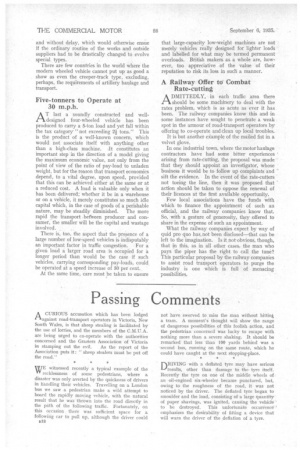Road Transport and War
Page 31

Page 32

If you've noticed an error in this article please click here to report it so we can fix it.
\V E are amongst those who believe that to be prepared, and yet not to display undue aggressiveness, is far more likely to prevent war than to encourage it, on the principle that it takes an exceptionally plucky, or even foolhardy, boy to challenge another who is an expert boxer.
In such preparedness, efficient road and crosscountry transport must undoubtedly occupy a position second to none in importance.
During recent years trials carried out by the British War Department have shown that improvements in the production of light chassis, combined with more generous tyre equipment, have resulted in vehicles which, at least in the lighter classes, can compete successfully with the rigid six-wheeler which, for long, held a prior place. That there is still a big field for the multiwheeler is unquestionable, but this lies chiefly in connection with the bigger loads.
It is the policy of the War Department to encourage the employment by civilian operators of types of vehicle which can, in case of necessity, be utilized just as effectively for military transport purposes. This is not only because, in this way, a reserve of vehicles is immediately available, but for the reason that the makers can at once devote their energies to building war machines under normal conditions of manufacture and without delay, which would otherwise ensue if the ordinary routine of the works and outside suppliers had to be drastically changed to evolve special types.
There are few countries in the world where the modern wheeled vehicle cannot put up as good a show as even the creeper-track type, excluding, perhaps, the requirements of artillery haulage and transport.
Five-tonners to Operate at 30 m.p.h.
AT last a soundly constructed and welldesigned four-wheeled vehicle has been produced to carry a 5-ton load and yet fall within the tax category "not exceeding 2i tons." This is the product of a well-known concern, which would not associate itself with anything other than a high-class machine. It constitutes an important step• in the direction of a model giving the maximum economic• value, not only from the point Of view of the ratio of pay-load to unladen weight, but for the reason that transport economics depend, to a vital degree, upon speed, provided that this can be achieved either at the same or at a reduced cost. A load is valuable only when it has been delivered; whether it be in a warehouse or on a vehicle, it merely constitutes so much idle capital which, in the case of goods of a perishable nature, may be steadily diminished. The more rapid the transport ,befween producer and consumer, the smaller will be the capital and wastage involved. .
There is, too, the aspect that the presence of a large number of low-speed vehicles is indisputably an important factor in traffic congestion. For a given load a larger road area is Occupied for a. longer period than would be the case if such vehicles, carrying corresponding pay-loads, could be operated at a speed increase of 50 per cent.
At the same time, care nmst be taken to ensure that large-capacity low-weight machines are not merely vehicles really designed for lighter loads and labelled for what may be termed permanent overloads. British makers as a whole are, however, too appreciative of the value of their reputation to risk its loss in such a manner.
A Railway Offer to Combat Rate-cutting
A DMITTEDLY, in each traffic area there should be some machinery to deal with the rates problem, which is as acute as ever it has been. The railway companies know this and in some instances have sought to penetrate a weak spot in the armour of road-transport operators by offering to co-operate and clean up local troubles. It is but another eXample of the mailed fist in a velvet glove.
In one industrial town, where the motor haulage contractors have had some bitter experiences arising from rate-cutting, the proposal was made• that they should appoint an investigator, whose business it would be to follow up complaints and sift the evidence. In the event of the rate-cutters not toeing the line, then it was proposed that action should be taken to oppose the renewal of their licences at the first available opportunity.
Few local associations have the funds with which to finance the appointment of such an official, and the railway companies know that. So, with a gesture of generosity, they offered to share in the expense of such an appointment.
What the railway companies expect by way of quid pro quo has,not been disclosed—that can be left to the imagination. Is it not-obvious, though, that in this, as in all other cases, the man who pays the piper has the right to call the tune? This particular proposal by the railway companies to assist road transport operators to purge the industry is one which is full of menacing possibilities.




























































































